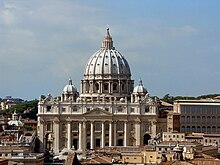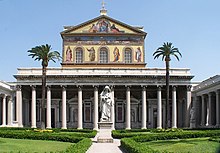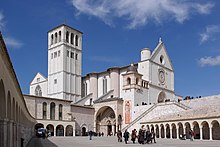This is an old revision of this page, as edited by JWBE (talk | contribs) at 16:25, 12 November 2010. The present address (URL) is a permanent link to this revision, which may differ significantly from the current revision.
Revision as of 16:25, 12 November 2010 by JWBE (talk | contribs)(diff) ← Previous revision | Latest revision (diff) | Newer revision → (diff)



Major basilica (Template:Lang-la, Basilica Maior in singular) is the title given to the four highest-ranking Roman Catholic churches.
All other churches that have the title of a basilica are minor basilicas (Template:Lang-la).
To this class belong the four great ancient churches of Rome:
- St. John Lateran, also called the Lateran Basilica, is the cathedral of the Bishop of Rome, the Pope. It is the only one called an "archbasilica". Its full official name is "Papal Basilica of Saint John Lateran, Archbasilica of the Most Holy Saviour and of Saints John the Baptist and the Evangelist at the Lateran, Cathedral of Rome".
- St. Peter's Basilica, also called the Vatican Basilica, is a major pilgrimage site, built over the burial place of Saint Peter. Perhaps the largest church in the world, it is used for most of the chief religious ceremonies in which the Pope participates. Its official name is the "Papal Basilica of Saint Peter in the Vatican".
- St. Paul Outside the Walls, also known as the Ostian Basilica because it is situated on the road that led to Ostia, is built over the burial place of Paul the Apostle. Its official name is the "Papal Basilica of Saint Paul Outside the Walls".
- St. Mary Major, also called the Liberian Basilica because the original building (not the present one) was attributed to Pope Liberius, is the largest church in Rome dedicated to the Blessed Virgin Mary, whence its name of Saint Mary Major, i.e. the Greater. Its official name is the "Papal Basilica of Saint Mary Major".
Privileges and attributes
These four major basilicas are also distinguished by their having a holy door and to which a visit is always prescribed as one of the conditions for gaining the Roman Jubilee. Furthermore, no one may celebrate mass at the high altar except the Pope and those specially delegated by the Pope to act in his stead. At least until recently, these churches were also open twenty-four hours a day and their staff included a college of priests whose sole function was to be continually available to hear confessions.
A former papal cathedra in the cloister of the Basilica of Saint John Lateran, Rome.
Lateran treaty
According to the 1927 Lateran Treaty, the three major basilicas located in Italian territory enjoy extraterritorial status similar to that of foreign embassies. The major basilicas are patrolled internally by police agents of Vatican City State and not by Italian police. These properties, scattered all over Rome, were found essential institutions necessary to the character and mission of the Holy See.
Decision of Pope Benedict XVI


The four papal or major basilicas were formerly known as "patriarchal basilicas". Together with the minor basilica of St. Lawrence outside the Walls, they were associated with the five ancient patriarchal sees of Christendom (see Pentarchy): St. John Lateran was associated with Rome, St. Peter's with Constantinople (present-day Istanbul), St. Paul's with Alexandria (in Egypt), St. Mary Major with Antioch (the Levant) and St. Lawrence with Jerusalem.
Upon relinquishing in 2006 the title of Patriarch of the West, Pope Benedict XVI renamed these basilicas from "Patriarchal Basilicas" to "Papal Basilicas".
Until Pope Benedict XVI, the title "patriarchal" (now "papal") was officially given to two churches associated with Saint Francis of Assisi situated in or near his home town:
References
- For ancient basilicas, it is often refer to them as Immemorial basilicas
- Basilica Papale di San Giovanni in Laterano - Arcibasilica del SS.mo Salvatore e dei Santi Giovanni Battista ed Evangelista al Laterano - Cattedrale di Roma (Annuario Pontificio 2007, ISBN 98-88-209-7908-9, p. 1332).
- Basilica Papale di San Pietro in Vaticano (Annuario Pontificio 2007, ISBN 98-88-209-7908-9, p. 1330).
- Basilica Papale di San Paolo fuori le mura (Annuario Pontificio 2007, ISBN 98-88-209-7908-9, p. 1333).
- Basilica Papale di Santa Maria Maggiore (Annuario Pontificio 2007, ISBN 98-88-209-7908-9, p. 1334).
- Template:PDFlink
- ^ Excerpt of extraterritorial jurisdiction as per the Lateran Treaty of 1929:
- Article 13
- Italy recognizes the full ownership of the Holy See over the patriarchal Basilicas of St. John Lateran, Sta. Maria Maggiore, and St. Paul, with their annexed buildings.
- The State transfers to the Holy See the free management and administration of the said Basilica of St. Paul and its dependent Monastery, also paying over to the Holy See all monies representing the sums set aside annually for that church in the budget of the Ministry of Education.
- It is also understood that the Holy See shall remain the absolute owner of the edifice of S. Callisto, adjoining Sta. Maria in Trastevere.
- Basilicas (www.gcatholic.com)
- Adrian Fortescue (1913). "Patriarch and Patriarchate" . In Herbermann, Charles (ed.). Catholic Encyclopedia. New York: Robert Appleton Company.
External links
Gietmann, G. and Thurston, Herbert (1913). "Basilica" . In Herbermann, Charles (ed.). Catholic Encyclopedia. New York: Robert Appleton Company.{{cite encyclopedia}}: CS1 maint: multiple names: authors list (link)
- List of All Major, Patriarchal and Minor Basilicas & statistics by Giga-Catholic Information.
